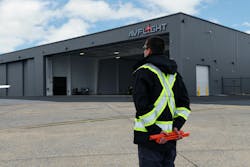Parking aircraft with wingspans of 30 to 100 feet is no small task. On the ramp, there are many obstacles to avoid, including other aircraft, ground support equipment (GSE) and even people.
It is imperative that aircraft are guided safely to their apron parking spot with the help of ground handling personnel, who are trained in marshalling and towing.
“Ground handling personnel are responsible for ensuring the safe movement of aircraft and equipment, protecting customers and employees alike,” says Casey Ross, safety, standards and training manager at Avflight. “The safe movement of aircraft on a ramp starts with training.”
Training for new employees and recurrent training at Avflight are both computer-based and on-the-job.
“New hires are provided a mentor to aid them at all times on the ramp until on-the-job training is complete. No Avflight employee performs any function independently until qualified by a trainer,” says Ross.
Marshallers Guide the Way
The primary responsibility of a marshaller is to determine a safe path of travel for the aircraft on ground.
“Generally, you’ll see one person marshalling an aircraft,” says Ross.
Initial parking instructions can be provided to the flight crew in advance by a phone call or email from the FBO, even before aircraft departure (and arrival at the FBO), Ross explains.
Prior to arrival, additional instructions can be communicated via radio or ACARS (Aircraft Communication Addressing and Reporting System), if the aircraft has the necessary hardware.
Then, after arrival, instructions can be provided via radio and hand signals.
“Instructions and plans can change quickly in busy environments. When verbal and radio communication between line technicians is hindered due to a noisy environment, visual communication with signals becomes the primary means of communication,” says Ross.
Often marshallers use handheld radios to communicate to other personnel that an aircraft is moving or about to move so that they keep clear of the area.
Different types and sizes of aircraft have individual needs when marshalling. For example, Ross says larger aircraft, or aircraft with additional blind spots, utilize wing walkers to provide a safe path of travel.
To accommodate additional aircraft during peak times, Ross says staffing is increased, and in unexpected high-traffic situations, a pilot may be asked to wait until the ramp is safe to enter.
From limited space and tight maneuvering to high-traffic operations, he says the majority of the challenges associated with marshalling are addressed with preplanning exercises.
“Planning is the No. 1 best practice an FBO can adopt to improve safety, efficiency and customer service. If we can identify and anticipate customer needs far in advance, we set ourselves up for success. We gather as much information as possible as far in advance as possible for every flight to create unique arrival plans for each operation,” says Ross.
Challenge mitigation strategies might include placing highly visible cones or markings near hazards, communicating in advance with the flight crew, and using wing walkers, says Ross. Wing walkers are responsible for communicating to both the marshaller and the flight crew any hazards that would prevent the safe taxiing of aircraft, says Ross.
He adds that both marshallers and wing walkers have the authority to stop an operation if it cannot be completed in a safe manner.
If there is too much risk involved, Ross explains operations will be halted, and another plan will be utilized.
“In extreme adverse weather, the operation will stop until it is safe to continue,” he says.
In addition to ramp safety training and on-the-job training, Ross says marshallers must complete training on signals and operations.
The International Civic Aviation Organization (ICAO) Annex 2 – “Rules of the Air” includes the standard marshalling signals that must be provided in a clear and precise manner.
“No person shall guide an aircraft unless trained, qualified and approved by the appropriate authority to carry out the functions of a signalman [marshaller, wing walker or person positioned at the aircraft wing tip].”
ICAO standards say marshallers are required to wear a distinctive fluorescent identification vest. During daylight hours, daylight-fluorescent wands, table-tennis bats or gloves are required for all signaling by all participating ground staff. At night or in low visibility, illuminated wands are required.
In addition to the ICAO standards, Ross says airlines have specific requirements and training.
Moving Aircraft on the Ground
The process for towing aircraft might seem similar to moving other equipment, but it’s not.
Due to the unique footprints of aircraft with different wing shapes, wheelbases, and tail heights, lengths and widths, towing aircraft can be quite challenging, describes Tyler Bellmore, director of training for LEKTRO product line at Oshkosh AeroTech.
Add to that, he points out that a simple scratch on an aircraft could potentially prevent it from departing.
“Towing aircraft is one of the most dynamic and challenging tasks in line services,” Bellmore says. “It requires a lot of knowledge and total focus. It is also one of the most important tasks for busy FBOs. Space is always limited at airports, and with constant arrivals/departures, moving aircraft safely and efficiently to make room for others is a constant dance, the success of which is critical to a positive customer experience and maximizing (and protecting) profits.
“Towing is also among the riskiest operations on the airfield. In addition to various obstacles, there are always time constraints and frequently a variety of movements occurring simultaneously. It is critical that a tow operator be observant, have great situational awareness and understand the various aspects of moving a multitude of different aircraft types to be successful.”
According to Bellmore, the greatest challenge for tow operators in the United States is the variety of aircraft and airframes.
“Each of those aircraft will have a unique connection point and various operational tow limits,” he says.
Oshkosh Aerotech maintains a Capture Table for its LEKTRO product line. In this document, each aircraft is listed by manufacturer, which LEKTRO model is capable of moving that aircraft, which attachments to utilize, as well as any special cautions/remarks.
“The key objectives when towing are to ensure personnel are safe, keep aircraft safe and keep flights on time – in that order. A few, very simple SOPs can help accomplish these objectives: maintain slow speeds, utilize wing walkers and ensure clear and proper communication,” Bellmore says.
“Staying up to date about new aircraft is also important. This knowledge should be refreshed periodically. In fact, yearly refresher training or even recertification is common in many locations.”
Ross describes training for tow operators is extensive.
“In order to be qualified as a tow operator, a large amount of training — both computer-based and on-the-job training — must be completed. After initial training, experience is the best tool available for continued training. Several trainers and managers — as well as the individual being trained —must all be comfortable before tow training can be considered complete and certification issued,” Ross says.
The Avfuel Training System provides guidance on towing procedures for the safe movement of the vast amount of aircraft types. Although Ross says it is uncommon, there are aircraft that Avflight is not equipped to tow due to not having the appropriate equipment or training.
“FBOs should always utilize aircraft-specific towing instructions. Every aircraft is different and requires unique procedures to safely tow,” says Ross.
In addition, any instructions specific to an aircraft operator are followed per the customer’s request.
To identify the safest and most efficient way to position aircraft, computer-based programming with preloaded aircraft dimensions is used, says Ross.
Radios and high-visibility wands in conjunction with an audible whistle assist with communication when towing takes place.
A pre-tow huddle with the team and a pre-tow walk-around of the aircraft are done to help ensure safe towing operations.
“If anything is deemed unsafe by the tow team, the movement is halted and re-addressed. If the movement cannot happen safely, it does not happen at all,” says Ross.
According to Ross, common challenges in aircraft towing operations include unfamiliar aircraft, adverse weather and pressure from customers.
“Weather (especially winter weather) has a large impact on towing operations. We always take ramp conditions into account — if there is snow or ice, we clear the ramp as much as possible, but also allow plenty of time to carefully steer, and appropriately brake or stop during a towing event. While we always strive to meet customer needs, safety must always take priority,” he says.
To improve towing operations, Avflight employs continual education on changing aircraft procedures and new best practices.
“Performance and efficiency are measured by utilizing ‘spot-checks’ completed by supervisors or management. This is a way of continuously improving by monitoring towing operations, and constantly coaching and educating personnel. While rare, incidents are tracked and thoroughly investigated in order to learn from and prevent future occurrences,” says Ross.
“It is important to continue training and enhancing knowledge of the ever-changing conditions of our industry.”






